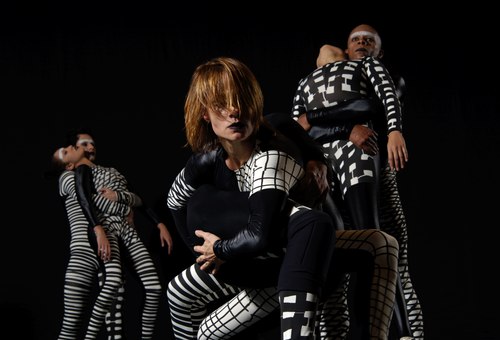|
 |
|
|
 |
 |
In dim light lines of 3-4 dancers moved in slow motion across Ohio State University's Mershon Auditorium stage. Crouched and swaying from side to side stretching their legs, the dancers created a slow moving panorama of bodies. In their midst a pas de deux couple traversed the stage at a more accelerated pace executing a succession of high flying lifts. The juxtaposition of fast and slow moving dancers onstage together would resurface with regularity in Grupo Corpo choreographer Rodrigo Pederneiras's Benguelê, a work celebrating Afro-Brazilian culture. Set to a varied musical score by guitarist/composer Joao Bosco, the 41-minute Benguelê unfolded in a swirling kaleidoscope of diverse images that ranged from animalistic, ritualistic and tribal to choreography infused with folk and social dance movement. In harmony with the rhythms of the 11 sections of Bosco's music for the work, Pederneiras's choreography for the Brazilian company's 25 or so dancers had them flopped over one another, sidling across the stage like orangutans, sharply bouncing their heads toward a shoulder and dancing en mass in unison. The most visually striking sections of the work came in its later half when the company's dancers in silhouette danced across a raised platform at the back of the stage that gave the impression of a distant landscape in the horizon. One by one in synch with each other and evenly spaced apart a la a Laura Dean ballet, the dancers in a seemingly endless line shimmied and stagger stepped horizontally from left to right entering and exiting the stage as if passengers on a moving walkway. The work closed with the full company costumed in black with white trousers that looked like ladies bloomers, and a variety of solid colored suspenders that matched the colors of a vertical stripped backdrop that resembled wrapping paper. The dancers once again in unison, engaged in up-tempo choreography that was buoyant, energetic, and laced with traditional African dance movements. Where Benguelê was primarily celebratory, the U.S. premiere of Pederneiras's Breu created a much darker atmosphere. Rows of shiny black squares resembling bathroom tiles encased the rear and side stage curtains from top to bottom creating a feeling of cold detachment. Dancers in white tribal-like make-up costumed in black and white stripped body suits with zebra colored dance sneakers lay motionless on the stage. They began to stir with introduction of Brazilian composer Lenine's eclectic and ambient score for the work which had a dark industrial tone interjected with sounds of English horns, rock guitars, drums and the noises of children's toys. Like fish out of water, Grupo's dancers on their backs, rolled up onto their shoulders and with one leg bent and the other leg straight, pushed off the floor with the bent leg catapulting themselves into the air and slightly backward only to immediately fall back down with a thud; repeating this bone jarring exercise over and over again. Breu at its core is an intensely violent work. It conjures up images of subjugation, abuse and just plain brute force. Aggressive floor work had the dancers rolling over repeatedly, flopping hard to the stage and executing hard-edged hip hop-like moves. One notable section featured a female dancer on her side on the floor running in a circle, grinding her shoulder into the marley floor with every leg turnover. Another saw a male and female dancer locked in a low-to-the-ground wrestling match, where each took turns trying to subdue or escape the other. As the pair wrestled, several male dancers stood in stillness nearby each clutching to their chest the motionless and limp body of female dancer; perhaps revealing the end result of the two wrestling dancer's struggle. Masterfully crafted, riveting to watch, and executed with conviction and abandon by its dancers, Breu is easily one of Pederneiras's very best and one of this dance season's best thus far.
 Grupo Corpo's Breu Photo © & courtesy of José Luiz Pederneiras |
|
 Grupo Corpo's Breu Photo © & courtesy of José Luiz Pederneiras |
|
|
|



